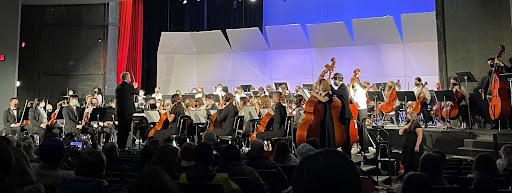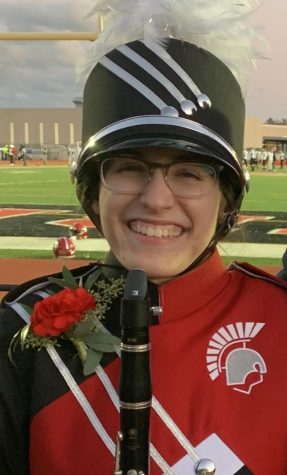Band and Orchestra Bridge in the DHS Symphony

The DHS Symphony at their February performance. Image courtesy of Ronald Velleuer.
March 10, 2022
At Deerfield High School, the symphony synthesizes the best of band and orchestra to create a unique ensemble. The DHS Symphony, as it is known, consists of winds, strings, and percussion. First emerging around the Classical period in Europe, symphony groups draw from centuries of diverse music. Since the DHS Symphony orchestra originated in the late 1960s, it has become a central element of the fine arts department. Also, because the ensemble combines musicians from both band and orchestra, its diverse instrumentation greatly expands the variety of pieces that it can play, making for unparalleled and memorable performances.
Mr. Ronald Velleuer, the orchestra director, has directed the DHS Symphony for twenty-one years. He said, “The string players are sophomore, junior, and senior string instrumentalists. Then, the wind and percussion players come from the Wind Ensemble, which meets during the same period.” Band and symphony compositions also differ because of the way that each ensemble is made up. Band pieces have multiple musicians of the same instrument playing different parts—where one might play the melody, another the harmony, and a third the foundation—but symphonies only have one or two wind instruments of each type playing a single part. Thus, the DHS Symphony uses its noteworthy makeup to showcase different pieces. “For example, you have tone poems, where composers tell a story without any words. They write music to represent ideas or characters. A character might be represented by the trumpet, and every time you hear the trumpet playing this theme, it represents the character. Or even through the harmonies, they can tell the story,” Mr. Velleuer added.
The variety of instruments in the DHS Symphony gives the group a distinct personality. Upper brass instruments like trumpets are characterized by their bright, strong sounds. In the symphony, they help carry rhythms, pronounce melodies, and accentuate climaxes in the music. Violins have high-pitched and keen attributes; accordingly, they often play the melody. Clarinets and oboes, which are distinguished by their warm tones and clear voices, respectively, may join the violins in this role. The light, acute flutes float on top with the main tune or embellish the piece through trills. All of the aforementioned instruments can also underscore the lower sections. In addition, they are accompanied by the violas, which are deeper than violins in both tone and pitch and thus frequently feature in harmonies. Similarly, low brass instruments like trombones balance out the higher notes while adding their own striking color, and French horns contribute powerful main themes or countermelodies. Cellos are notable for their deep tones and extensive ranges, and they may play melodies or provide support; when coupled with the smooth, low-pitched bassoons, they give the symphony a fuller sound. Joining the tubas and the basses—the former known for their low, rich quality and the latter for their dark, velvety timbre—creates a solid foundation for the ensemble. Finally, the percussion are essential for driving tempo and keeping rhythm. They add new effects to the music as well, playing multiple instruments with different characteristics.
Furthermore, there is a tremendously wide selection of music that symphonies can play due to their composition, with parts written for orchestral strings and certain band instruments. When selecting pieces for the DHS Symphony, Mr. Velleuer takes advantage of this scope. “There’s hundreds of years of music that orchestras have to draw on…and there’s new music being written for symphonies every day… So there’s this great canon of literature that exists,” he said. “I want to look for music that gives everyone an opportunity to play something interesting. I want to have something that has educational value. ‘What can I teach through this music? What new techniques are [the students] going to need to learn to play this music?’” By playing pieces from multiple genres and composers, musicians in the DHS Symphony can practice challenging rhythms, widely different ranges, and new techniques.
Moreover, the DHS Symphony gives its students the opportunity to develop their talents as musicians. Senior Liana Oshin, a flutist, has been part of the ensemble for three years. She expressed, “I think [the Symphony pieces] have a lot of power and a lot of connection. We’re exposed to many different genres.” Additionally, musicians in the DHS Symphony learn how to perform in different settings and contexts. “If you’re coming from a band piece to an orchestral piece, you have to think about it in a completely different way. You’re melding with an orchestra; you’re melding with a softer, smoother, richer sound, and that’s something you need to really blend into,” Oshin described. Being in the DHS Symphony has offered her a particular environment to play in, which will serve her in future musical endeavors. She also explained how her part in the symphony encourages her to expand her technical skills with her instrument, saying, “The flute goes into much lower notes and ranges than it does in band… and oftentimes, they’re written as forte [loud], so getting that power and practicing is interesting.” Recalling a performance of a piece from the ballet Swan Lake, Oshin described, “The double tonguing was very different, and there were six sharps at one point…but it was all great and fun. It was very enjoyable, and I like that there are different challenges from the band pieces that make me want to continue in Symphony.”
From the perspective of the director, Mr. Velleuer elaborated, “I like to have great contrast and explore a wide variety of styles. I want to explore music from all different cultures, from all different countries.” In the past, the DHS Symphony has traveled outside the country and performed for other ensembles and audiences. This presents a unique opportunity for the musicians to not only play a piece, but also experience its country of origin firsthand. Mr. Velleuer recounted, “When we went to Italy a couple of years ago, we did a medley of music from The Greatest Showman, the overture of The Barber of Seville, and even Copland’s “Hoe-Down”… I like to be super inclusive of styles and composers—as much variety as I can find. A great program has a little bit of everything in it.”
In its most recent concert, the DHS Symphony performed the “Russian Sailor’s Dance,” a movement from the Soviet ballet The Red Poppy. Originally created in 1927, the composition depicts a story through music. As Mr. Velleuer explained, “It’s a highly energetic piece. The tempo starts out very fast and heavy, with the low strings and the low brass driving the rhythm… then, you have this robust theme that enters in the cello and bass, meant to represent the burly Russian sailors that are carousing in the bar… then, the woodwinds come in, and they take over while the strings are playing pizzicato [plucking strings].” Using the special instrumentation of the symphony, the piece evokes heightening emotions. Mr. Velleuer continued, “It gets broader, with a more majestic feeling, and then it all breaks loose. It gets louder and higher and faster until it ends with a big bang. That’s fun and exciting… It’s representing these characters, and it’s all told through the instrumentation. Every instrument gets a chance to shine.”
The DHS Symphony orchestra will perform next on March 17th at 7:30 PM in the DHS Auditorium. With its dynamic instrumentation and skillful musicians, it will continue to showcase music from around the world, various time periods, and an expansive range of genres, presenting vivid sounds and captivating pieces that only a symphony can play.


Rosie Stephens • Mar 17, 2022 at 9:45 am
This article is very well written. The words flow so well that it makes me feel as if I’m watching the musicians with their instruments get on stage. Congratulations Gabriella